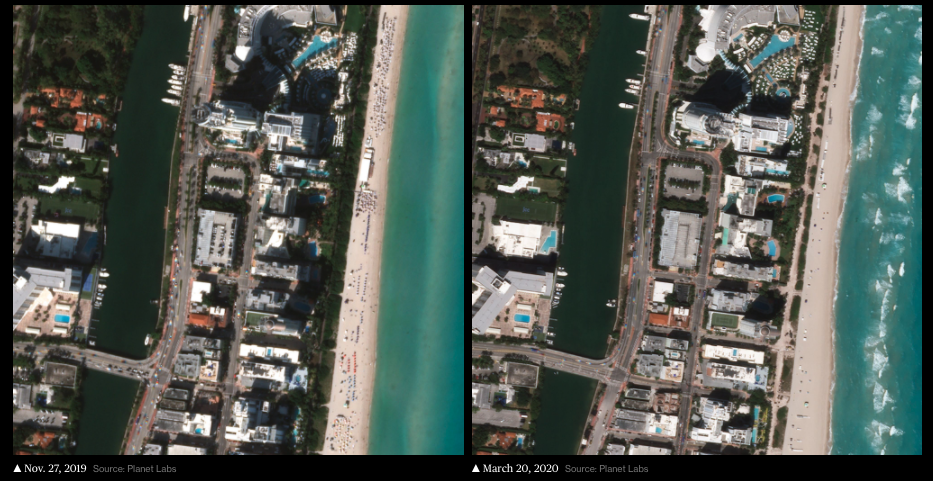Stunning Satellite Images Show What It Looks Like When The World Stops
The virus shock that has struck the global economy has been far faster and more severe than the 2008 financial crisis, Dot Com bust, and even the Great Depression.
In one fell swoop (several months), the global economy has ground to a halt; stock markets have crashed 30-50%, credit markets have frozen, commodities tanked, bankruptcies and bailouts seen, massive unemployment and worldwide GDP cratered.
Strict social distancing measures, mass quarantines, and travel bans across the world to combat the fast-spreading COVID-19 outbreak has been the reason why the global economy has crashed. At this very moment, more than a billion people are confined to their homes, some of the largest factory hubs are shuttered, and education systems are closed indefinitely.
JPMorgan Chase & Co. describes this moment as “the day the earth stood still.” Wall Street anxieties are growing by the day as a protracted shutdown of the global economy could trigger a depression.
To give you a worldly view, one from outer space, Bloomberg shares images from satellite company Planet Labs Inc.’s SkySat imaging orbiters that shows certain regions across the world that have ground to a halt:
Wuhan’s Yingwuzhou Yangtze River Bridge (before and after shutdown):
The first image of Wuhan’s Yingwuzhou Yangtze River Bridge was taken Jan. 12, one day after Covid-19 took its first known life in China. By the time the second photo was taken, Wuhan was quarantined, China had seen 17 more deaths, and Asian neighbors and the U.S. counted their first cases. The disease had already escaped. – Bloomberg
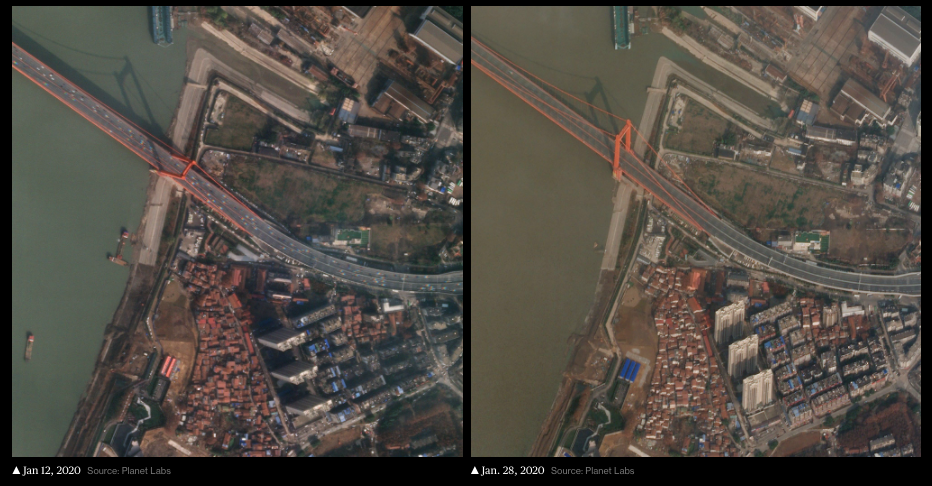
Great Mosque of Mecca, Islam’s holiest site (before and after shutdown):
At the heart of the Great Mosque of Mecca, Islam’s holiest site, sits the Kaaba, the cubic structure that orients Muslims’ daily prayers around the world. At the peak of the pilgrimage called the Hajj in late-July and early August, some 2 million people from around the world make their way to the site at once. On Feb. 27, Saudi Arabia closed its borders to international pilgrims. The nation took further steps to limit access to the shrine over the next three weeks until it temporarily suspended all entrance and prayers on March 20, leaving the site empty. – Bloomberg
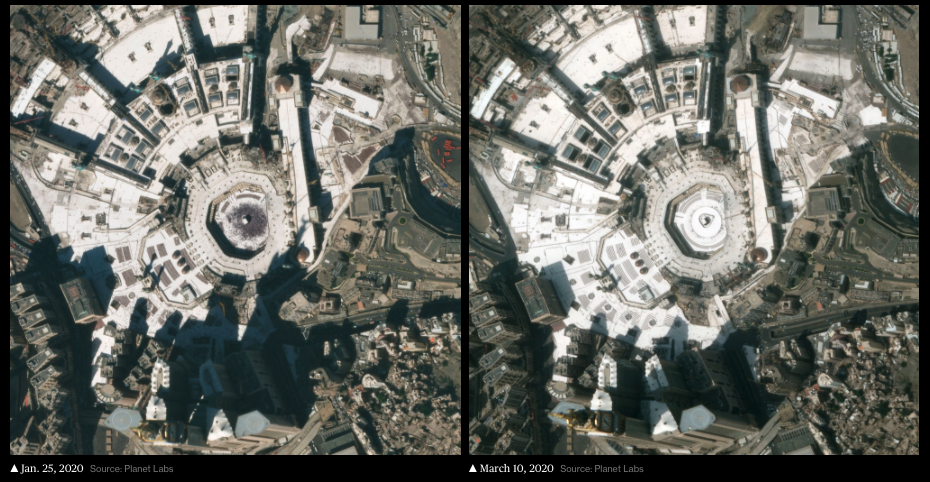
Grand Canal channel in Venice, Italy (before and after shutdown):
Italy’s Prime Minister Giuseppe Conte snapped Europe to attention on March 8 when he ordered a lockdown of the country’s northern region, which includes Venice. A day later, he extended the lockdown nationwide. Within days of the closure, Venetians were startled to see that their canals and perimeter waterways becalmed. Without the usual human tumult churning the waters, the canals were suddenly still and clear. – Bloomberg
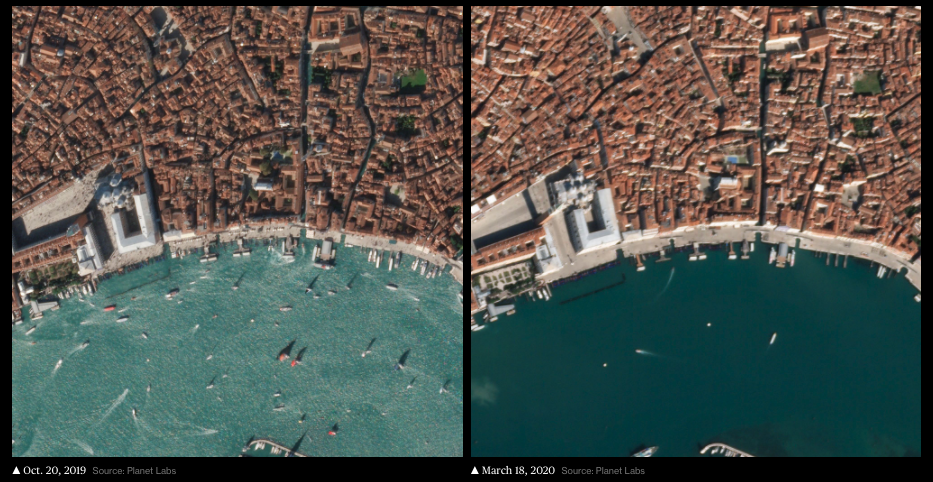
Epcot Center in Bay Lake, Florida (before and after shutdown):
Epcot Center in Bay Lake, Florida was meant to be the realization of Walt Disney’s fundamentally optimistic vision of a technology-driven global future. On March 18, two days after The Walt Disney Co. temporarily suspended theme-park operations and with many nations restricting overseas travel, its vast parking lots were empty of visitors’ cars. –Bloomberg
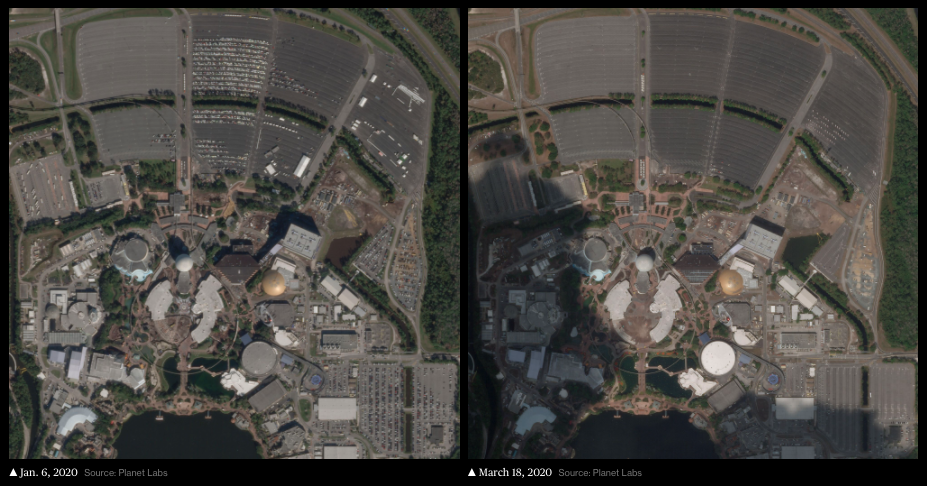
Volkswagen’s Tianjin, China factory (before and after shutdown):
Within days of Volkswagen AG’s March 17 decision to halt production for up to three-weeks, CEO Herbert Diess said it might not be long enough given the necessary “drastic measures to protect liquidity.” After Germany asked its largest carmakers to help make masks and ventilators to treat Covid-19 victims, Volkswagen began building up production capacity in China. The company’s Tianjin, China, plant is pictured here. –Bloomberg
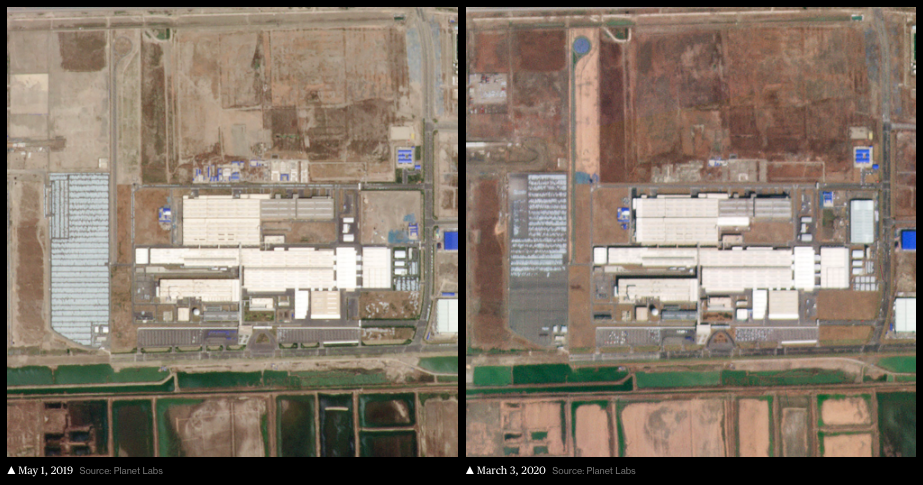
Miami Beach (before and after shutdown):
Few places have struggled as vividly with coronavirus-related precautions as Miami Beach, where the disease arrived just as college students descended for spring break. With the state reluctant to demand sweeping closures, local officials in towns and cities began to shut down their most prized money-makers. The City of Miami Beach issued a nighttime curfew on beaches and required non-essential businesses to close daily by 10 pm on the 15th. By the 18th, all beaches were closed in the city and Miami-Date County. On the 20th, the city closed hotels and other lodging services. – Bloomberg
Even if the pandemic and economic fallout were brought under control in the months ahead, there are still tail risk events that could trigger financial Armageddon.
Afterall, Guggenheim’s Scott Minerd declared on Bloomberg TV:
“…this is possibly the worst thing I have seen in my career… it’s hard to imagine a scenario in which you can contain the virus threat,” adding that “Europe and China are probably already in recession and US GDP will take a 1.5-2.0% hit.”
Guggenheim’s Scott Minerd says the coronavirus crisis is possibly the worst thing he’s ever seen in his career: “This has the potential to reel into something extremely serious” pic.twitter.com/xLhhNm3u7t
— Bloomberg TV (@BloombergTV) February 27, 2020
Tyler Durden
Tue, 03/24/2020 – 21:25![]()
Zero Hedge’s mission is to widen the scope of financial, economic and political information available to the professional investing public, to skeptically examine and, where necessary, attack the flaccid institution that financial journalism has become, to liberate oppressed knowledge, to provide analysis uninhibited by political constraint and to facilitate information’s unending quest for freedom. Visit https://www.zerohedge.com
